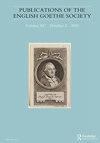1800年前后的种族与殖民主义:赫尔德、菲舍尔、克莱斯特
IF 0.1
3区 文学
0 LITERATURE, GERMAN, DUTCH, SCANDINAVIAN
引用次数: 0
摘要
摘要Herder的《Neger Idyllen》、Kleist的《Die Verlobung in St.Domingo》和Caroline Auguste Fischer的《William der Neger》探讨了1800年前后大西洋世界和欧洲种族与殖民主义之间的交叉。教学生阅读对种族、暴力和解放斗争的描述,不仅涉及启蒙运动的令人担忧的遗产,而且从实际意义上讲,这也是一种可疑阅读的练习。赫尔德的反帝国主义和反奴隶制诗歌以不安的家长式谈判结束。克莱斯特的中篇小说提供了一个带有种族偏见的叙述者,他限制了非白人角色的思维过程。菲舍尔的短篇小说致力于维护解放的理想,但对革命暴力的必然结果感到退缩,并塑造了两个无法调和的主人公形象:一个是基于种族身份的内化的自我仇恨,另一个是被压迫人民的基督般的救世主。本文章由计算机程序翻译,如有差异,请以英文原文为准。
Race and Colonialism around 1800: Herder, Fischer, Kleist
ABSTRACT Herder’s ‘Neger-Idyllen’, Kleist’s Die Verlobung in St. Domingo, and Caroline Auguste Fischer’s William der Neger offer an exploration of the intersection between race and colonialism in the Atlantic World and in Europe around 1800. Teaching students to read depictions of race, violence, and struggles for emancipation does not only engage with the fraught legacies of the Enlightenment, but, practically speaking, it is also an exercise in suspicious reading. Herder’s anti-imperialist and antislavery poems end with an uneasy negotiation of paternalism. Kleist’s novella provides a racially biased narrator, who limits access to the thought processes of non-white characters. Fischer’s short story moves towards upholding an ideal of emancipation, but recoils from its corollary of revolutionary violence, and crafts two images of its protagonist that cannot be reconciled: one of internalized self-hatred, based on racial identity, the other, of a Christ-like saviour for oppressed peoples.
求助全文
通过发布文献求助,成功后即可免费获取论文全文。
去求助
来源期刊

Publications of the English Goethe Society
LITERATURE, GERMAN, DUTCH, SCANDINAVIAN-
CiteScore
0.10
自引率
0.00%
发文量
15
 求助内容:
求助内容: 应助结果提醒方式:
应助结果提醒方式:


